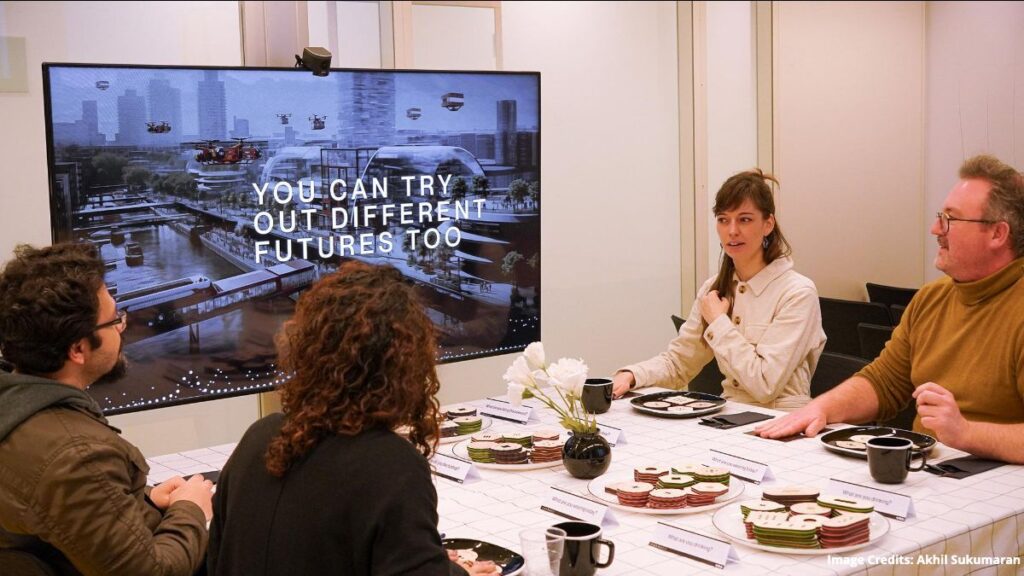Transition-Scapes Closing Event: Reimagining Energy Futures
Events
The Civic Interaction Design Research Group and the Nieuwe Instituut invite you to the closing event of the Transition-Scapes research project. The event will present the project’s design framework and the results of the exploration on using interactive exhibition forms to help orchestrate locally organized energy systems and drive institutional change.

Over the past two years, Transition-Scapes has explored how interactive exhibition formats can visualize future energy transition scenarios, making their implications tangible and open for discussion at the neighborhood level.
Through a research-through-design approach, researchers, designers, policymakers, and energy experts collaborated to develop interactive tools that foster dialogue between residents and institutional stakeholders. These tools, tested in Amsterdam Haven-Stad and Huis van de Toekomst in Rotterdam, offer insights into how local energy systems can be collectively imagined and shaped.
This event will present the Transition-Scapes design framework, demonstrating its potential to support locally organized energy systems and institutional change. The program features expert presentations, interactive demonstrations of simulation models, and discussions on the role of design in shaping future energy governance.
Programme
Moderator: Saskia van Stein (Artistic and Managing Director at the International Architecture Biennale Rotterdam and project partner for the Transition-Scapes research)
Language: English
| 13:30 | Doors open |
| 14:00 – 14:10 | Word of welcome by Martijn de Waal (Professor at Civic Interaction Design) and Francien van Westrenen (Head of Agency at Nieuwe Instituut) |
| 14:10 – 14:25 | Presentation on outcomes Transition-Scapes by Linda Vlassenrood (Curator and Research Lead) and Cristina Ampatzidou (Design Researcher) |
| 14:25 – 14:55 | Demonstration of the simulation models for Huis van de Toekomst and Haven-Stad by Dirk Bertels and Arthur van Schravendijk (Studio Bertels) |
| 14:55 – 15:15 | Presentation by Pallas Agterberg (Change Officer at Alliander) on the need for a locally organised energy system and how the design framework of Transition-Scapes can help in achieving this |
| 15:15 – 15:45 | Discussion with Melle Smets (Artist and Co-founder Huis van de Toekomst), Petra Hofman (Co-founder Diep) and others |
| 15:45 – 16:00 | Break |
| 16:00 – 16:20 | Presentation by Thijs van Spaandonk (Chief Government Advisor on the Built and Rural Environment / Co-founder Bright) on the need for institutional renewal and how the design framework of Transition-Scapes can help in achieving this |
| 16:20 – 16:50 | Discussion with Mees van Tooren (Action Researcher at Klimaatwerk – Instituut voor Publieke Waarden), Petrus Postma (Co-founder &Flux) and Arjan Klok (Senior Urban Planner City of Amsterdam) |
| 16:50 – 17:00 | Recap of event and recommendations by Martijn de Waal |
| 17:00 – 18:00 | Drinks |
Registration
Haven-Stad
Haven-Stad is the current industrial area in Amsterdam between Sloterdijk, the Westerpark, the Cornelis Douwes site and the Noorder IJ-plas. In the coming decades, this area will transform into a new urban development with 40,000 to 70,000 new homes, 45,000 to 58,000 jobs and commercial functions. Haven-Stad is currently the largest urban expansion in the Netherlands. In some areas, homes cannot be built until 2029, but construction has already started in Sloterdijk. The developments of Haven-Stad will run until 2055.
Huis van de Toekomst
Huis van de Toekomst was founded in Rotterdam in 2019. It is a neighbourhood initiative in the J.J.P. Oudblock, a residential building block with social housing in Bospolder-Tussendijken (BoTu). BoTu is one of the poorest neighbourhoods in the Netherlands and one of the first Rotterdam districts to become natural gas-free. The goal of Huis van de Toekomst is to turn the building block into an energy community that is entirely free of fossil fuels, creating a living example of what a human-powered community could look like. In 2024 and 2025, 14 houses and courtyards will become one shared household where neighbourhood strength is central. Baking bread together, insulating houses from old clothes, a communal garden for people and animals, natural gas-free cooking, yoga, massages and other bodywork. This is how the energy community is created with human power as the vital energy source.
Civic Interaction Design
Civic Interaction Design is an interdisciplinary research group at the Amsterdam University of Applied Sciences. Together with students, designers, technology developers, policymakers, (local) governments, academic researchers, and citizens, we explore how design & technology can contribute to civic life: the numerous and varied interactions through which people in a society come together to strive towards collective well-being.